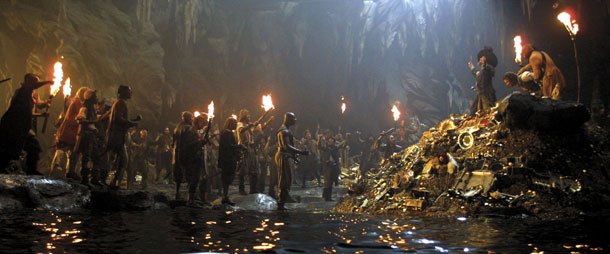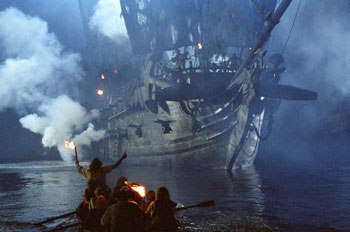Gerard Raiti sits down with Pirates of the Caribbean animation supervisor Hal Hickel to chat about how ILM helped bring the dead back to life and were not just talking about the pirate film genre here.

The transformation of Geoffrey Rush proved to be a big challenge. Photo Credit: Industrial Light & Magic. Unless otherwise noted, all images from the film Pirates of the Caribbean © Disney Enterprises Inc. and Jerry Bruckheimer Inc. All rights reserved.
Yo ho, ho, ho, a pirates life for me! That is the opening verse audiences are singing as they depart from Walt Disney Pictures Pirates of the Caribbean: The Curse of the Black Pearl. Amidst a season filled with high-budgeted sequels, Pirates emerges as the surprise of the summer, thanks mostly to a near-perfect hybridization of an impelling story and VFX. In a film that could have easily become a spoof of the Disneyland ride or an overblown fizzle like The Adventures of Rocky and Bullwinkle, the respectful approach and attention to detail in Pirates, which stars Johnny Depp, would have made Walt Disney proud. The creative vision of director Gore Verbinski and producer Jerry Bruckheimer, coupled with the VFX crew of Industrial Light & Magic, honed Pirates into sheer fantasy splendor, creating the cinematic ride of the year.

Director Gore Verbinski (center) talks to a pirate extra (left) and Jack Davenport (right) on the set. ILM and Verbinski had biweekly videoconferences during the making of the movie. Photo Credit: Elliot Marks, SMPSP.

Hal Hickel, animation supervisor at ILM. Courtesy of ILM.
With roughly 200 people, including 25 animators, the ILM crew was larger than usual, mainly due to Pirates rapid production schedule, which ran from October 2002 through June 2003. ILM contributed more than 300 FX shots. Alias|Wavefronts Maya was the primary modeling and animation software used in the film, which is atypical for ILM. Traditionally, ILM uses SoftImage 3.9, but beginning with recent films such as Hulk, ILM has begun leaning toward Maya, the industry standard. For the remainder of the FX operations, including rotoscoping, optical motion capture, facial animation and cloth, ILM employed its own in-house programs.
Typically, a pirate film would not require hefty visual effects, but Pirates has a twist: as its subtitle trumpets, there is a curse. The crew of the pirate ship The Black Pearl harbors a curse for stealing Aztec treasure sullied by the sins of Cortez himself. The consequence of this curse leaves the pirates immortal and without somatic senses. More importantly, the moonlight reveals the true figures of the pirates: they are skeletons. Audiences have Ted Elliott and Terry Rossio (screenplay and screen story) to thank for this innovative spin on the rides story; these two Hollywood corsairs were previously responsible for penning Aladdin and Shrek, among other successes. They waited nearly 10 years to have a studio pick up their supernatural take on a pirate tale.
The Bones in Davy Jones Locker
The incorporation of skeletons and nautical antics provided the most CG work for ILM. As Bruckheimer concurred at the films gargantuan premiere at Disneyland, The transformation and gore associated with the pirates was by far the most challenging visual effects part of the movie. ILM did a fantastic job!
Hal Hickel, animation supervisor at ILM, agreed that the skeletons provided the most challenging aspect of the visual effects. Also within that, the close-up shots where characters transformed from human to skeleton were the most difficult. When the camera is that close, as is the case for example when Geoffrey Rush (Captain Barbossa) makes his first skeletal transformation, it was important to make sure that the facial features, concepts and costumes looked perfect because they all had lots of detail. Many of the characters have trinkets and talismans woven into their hair. The animators had to make sure that none of those details were excluded in the modeling of the skeletons, or else the transitions would not work.
The fight scenes between the British Navy and the pirates proved to be the most problematic for the filmmakers. In order for ILM to animate the skeletons akin to Verbinskis vision, most scenes were shot twice. First wed photograph the British Navy and the pirates fighting, explained Verbinski. Then wed do another reference pass with just the Navy, followed by another with just the pirates. The guys are essentially fighting air.

It took a huge production crew five months to painstakingly build Captain Barbossa's spectacular hideaway. Photo Credit: Elliot Marks, SMPSP.
Although the VFX do not dominate Pirates to the extent of The Matrix Reloaded or Terminator 3, the movie does have moments of eye-candy bliss. The buzz after the films premiere was how seamlessly animated the scenes are when the pirates battle the British Navy while weaving in and out of the moonlight, causing the pirates to constantly morph between human and skeleton forms. The visual apex is the final battle between Depp and Rush, in which ILM skillfully hews a live-action, CG-hybrid sword fight on par with Yodas fight scene in last years Star Wars Episode II. Hickel detailed how ILM achieved this stupendous effect: We began with the plate that had the character actually in it. Then we would paint them out in the moonbeams, and our skeleton goes right atop where they were.
Since the ILM effects crew had reference scenes with the actors, they were able to animate the skeletons so that their body language was analogous to their live-action counterparts. When you see the characters as skeletons, youll know immediately which pirate is which, added Verbinski. Even when theyre 100% computer- generated and their clothing is in shreds, youll know. Not just from the actors voice, but from every nuance, which is why we shot entire scenes only as reference. Furthermore, ILM had biweekly videoconferences with Verbinski and others to insure that the animators were working according to Verbinskis vision.

The production team decided that CG ships wouldn't have given the right feel to the movie, so they built the real thing. Photo Credit: Elliot Marks, SMPSP.
A Pirate Without a Boat Is Like a Knight Without His Horse
Not all of the noteworthy VFX in Pirates involved computers. The most intensive and onerous effects were necessary to facilitate filming the sundry locations and the massive 18th century-style nautical vessels that went with them. After all, what would pirates be without their boats!
We chose not to make CG ships because the ships play such a prominent role in the film. Sometimes you cant beat the real thing, commented Hickel regarding the construction of three scaled ships representing the Interceptor, the Dauntless and The Black Pearl, as well as the renovation of the Lady Washington, a full-scale historic reproduction ship that stood in for the Interceptor.


Built in 1967, Pirates of the Caribbean remains one of the park's most popular rides. Courtesy of Disneyland Resorts.
"Beyond Here, There Be Dragons.
There is one visual effect in Pirates that was more than 35 years in the making: the references to the theme park ride. The ride, created by Marc Davis and Disney, was an innovative wonder at its inception, being one of the first rides to feature animatronics. Moreover, its captivating and intriguing story has stood the test of time, as it has been one of the most popular rides in Disneylands tenure. Although the ride has a story, albeit Davis and Disney were probably the only ones to fully understand it, the film is not an adaptation of the rides story. Rather, it is a pirate tale that successfully seeks to capture both the splendor and fascination that the ride has evoked for decades. The film references most of the scenes that the ride portrays. The writers did not plan this directly, but every time a scene occurred in the film where there was some similarity in either characters or locale, the writers steadfastly inserted tributes of homage to the movies eponymous namesake. For example, once the British Navy capture Depp's Jack Sparrow at Port Royal, the writers knew they must incorporate the classic scene of pirate prisoners tempting a dog that is holding the keys to the cells. There are also some references to pirate persiflage, such as the classic Cartesian line that appeared on Ancient and Medieval maps, Beyond here, there be dragons. All of these moments throughout the film, like the skeleton pirates drinking wine that flows right down their bones, are such a sparingly witty throwback to the films heritage that one can only bow or curtsy before the adeptness of the films creative crew, for few VFX can evoke ones childhood.
ILM and VFX
As Hickel clarified, the extent to which VFX are in the forefront of a film makes little difference to the ILM crew. Regardless of the movie, its kind of the same thing. You have to create something that the audience knows cant be real, but youre trying to make it as real as possible. The films story sets it up in a way that people want to believe in. Our job is to make it real enough that you believe its something you could touch or stand next to. On some level, the audience has to believe they could bump into it. If the audience can sense the bad breathe of the pirate skeletons, then weve done our job. Only time will tell if the film will stand a worthy testament to its theme park ancestor. Nevertheless, Verbinski, Bruckheimer and the ILM crew have created a film of Walt's caliber, seeking to fuse a captivating story with state-of-the-art visuals.
Gerard Raiti is interning as an animation and media research analyst at DUCK Studios in Los Angeles. In the fall, he will be a senior at Vanderbilt University, majoring in English, music and computer science. He has been writing about animation since 1997 because he loves cartoons and their cathartic effect on viewers. After college, he aspires to work as a media analyst at a childrens programming network before earning his MBA.








